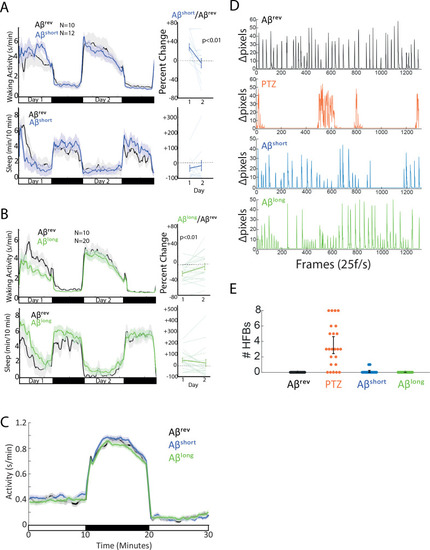|
Aβ-injected larvae recover after 24 hr and do not exhibit seizure-like or sickness behavior.(A–B) The effects of Aβshort (A) and Aβlong (B) on waking activity (top) and sleep (bottom) return to baseline after 24 hr. Shown in A and B are traces for 48 hr post-injection on a 14 hr:10 hr light:dark cycle (indicated by the white and black bars). The ribbons represent ±the SEM. Plotted on the right are the percent change induced by Aβ relative to Aβrev for day 1 versus day 2, demonstrating that these parameters return to baseline (*p≤0.01, paired t-test). Each line represents a single larva, the thicker line represents the mean ± SEM. (C) Activity traces of Aβshort (blue), Aβlong (green), and Aβrev (black) during and after a ten minute dark pulse are indistinguishable. Traces are for a 10 min:10 min:10 min light:dark:light window (indicated by the white and black bars). The ribbons represent ±the SEM. (D) The effects of Aβrev (black), convulsant PTZ (10 mM, orange), Aβshort (blue), and Aβlong (green) on sub-second larval bout structures. Shown are delta pixel movement of one representative larva in each group for ~1 min (see Figure 1—video 1). Unlike PTZ treated larvae, Aβ injected larvae have normal bout structures. Representative larvae were chosen to also highlight that, while overall Aβlong injected larvae are less active, individual animals can have sustained periods of heightened activity. Similarly, individual Aβshort injected animals can exhibit periods of relatively dampened activity. (E) The effects of Aβrev (black), convulsant PTZ (10 mM, orange), Aβshort (blue) and Aβlong (green) on high-frequency bouts (HFB) in a 5 min interval. Each dot represents a single larva. PTZ-induced HFB’s is non-existent or very rare in the other groups (n = 24 for all groups).
|

